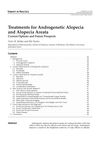Alopecia in Women: A 2003 Review
March 2003
in “
PubMed
”

TLDR Hair loss in women can be due to abnormal hair growth cycles or damaged hair follicles, with the most common type being androgenetic alopecia; treatment varies by cause, and the psychological impact is significant.
The 2003 review "Alopecia in women" categorized alopecia into two types: disorders where the hair follicle is normal but hair growth cycling is abnormal, and disorders where the hair follicle is damaged. Androgenetic alopecia was identified as the most common cause of hair loss in women. Other disorders included alopecia areata, telogen effluvium, cicatricial alopecia, and traumatic alopecias. Diagnosis was typically based on a thorough history and a focused physical examination, with some patients requiring selected laboratory tests or punch biopsy. Topically administered minoxidil was labeled for the treatment of androgenetic alopecia in women, while corticosteroids and other agents were typically used in women with alopecia areata. Telogen effluvium was often a self-limited disorder. The review emphasized the importance of assessing the psychological effects of alopecia on women due to its potentially devastating impact.







